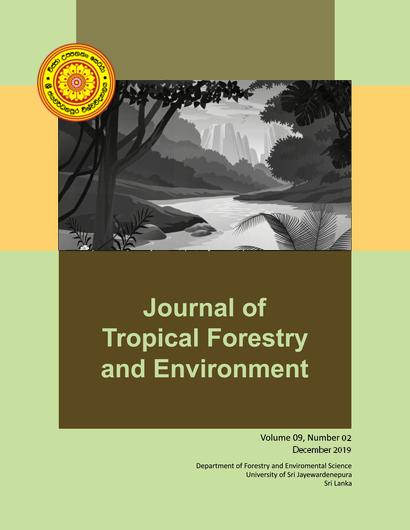Variation of Water Quality of Four Micro Watersheds Outlets in Upstream of Mahaweli River during Maha Cropping Season
DOI:
https://doi.org/10.31357/jtfe.v9i2.4467Abstract
Non-point source, agriculture based pollutants have been identified as one of the main cause for water pollution in Sri Lanka. Naranhinna, Pambadeniya Kappeti-Ela, and Rajamale micro watersheds located in the Kandy district have been identified by the project on Rehabilitation of degraded agricultural lands in the Central Highlands implemented by Food and Agricultural Organisation (FAO) to rehabilitate through watershed management plan. This study assessed the baseline water quality status of these micro watersheds by obtaining water samples at the outlet of each watersheds during the Maha cropping seasons 2018/2019. Three replicates water samples from each outlets were collected six times and analysed for EC , pH, TDS, CO32-, HCO3-, NO3-, NH4+, available P, total K, Na, Ca, Mg, Fe, Al, As, Cd, Cr, Mn, and Pb using standard methods. Most of the tested drinking water quality parameters in all four micro watersheds were within the permissible limits of World Health Organisation (WHO) standard except Fe and NH4+. Observed Fe contents exceeded the WHO limits (0.3 mg/L) of all watersheds and was in the range of 1.2-1.5 mg/L. Concentration of NH4+ at Kappeti Ela, Rajamale, and Pambadeniya was in the range of 0.5 to 0.7 mg/L which exceeded the WHO standard (0.5 mg/L). Using the tested parameters, study calculated drinking water quality index (DWQI) and also irrigation water quality index (IWQI) for all investigated micro watersheds for each of the sampling date. According to the guideline, mean DWQI (19 to 48.1) graded the water of all micro watersheds as excellent while IWQI (8.7-9.2) characterised them as excellent for any crops during the study period.Downloads
Published
2020-02-11
How to Cite
Abeysingha, N., Madusanka, M., Rotawewa, B., & Gunasena, N. (2020). Variation of Water Quality of Four Micro Watersheds Outlets in Upstream of Mahaweli River during Maha Cropping Season. Journal of Tropical Forestry and Environment, 9(2). https://doi.org/10.31357/jtfe.v9i2.4467
Issue
Section
Articles
License
The publisher retain the copyrights of contents published, and all open access articles are distributed under the terms of the Creative Commons Attribution-Noncommercial-No Derivative Works 3.0 Unported License[U1], which permits unrestricted use, distribution and reproduction in any medium, provided that the original work is properly cited.
You can download the Legal Code for this License at: http://creativecommons.org/licenses/by-nc-nd/3.0/legalcode


